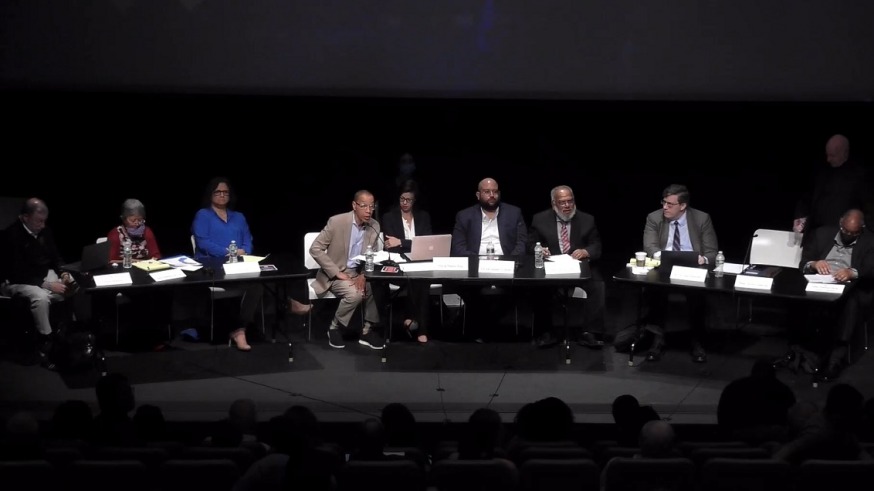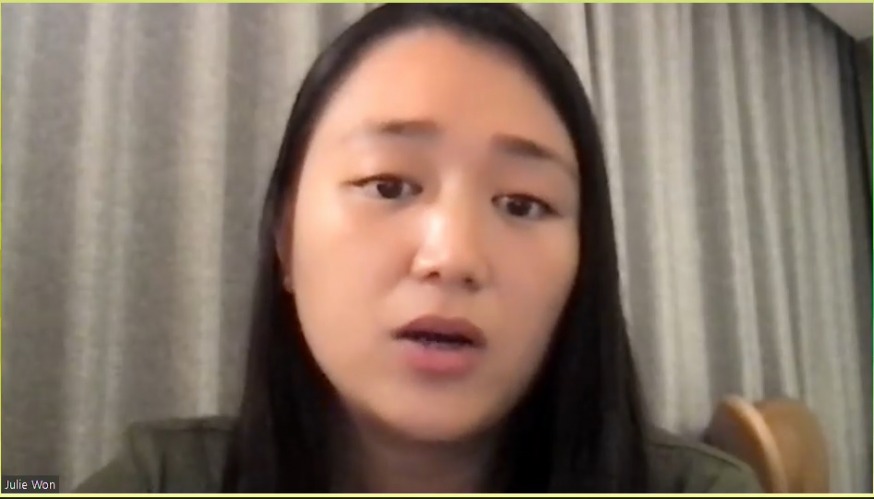
The NYC Districting Commission at the public hearing at the Museum of the Moving Image in Astoria Tuesday. The meeting was led by Dennis Walcott, the commission chair. (Photo: Screenshot of event)
Aug. 18, 2022 By Christian Murray
Hundreds of people testified virtually and in-person Tuesday night during a public meeting in Astoria that they do not approve of the changes proposed by the NYC Districting Commission to the boundaries of Council District 26.
The hearing, a marathon session that lasted more than six hours, was held to provide the public with the ability to weigh in on the commission’s proposed changes to all 51 council districts—although a significant portion of the evening dealt with Council District 26.
The proposed change to the District 26 map would see the Woodside portion of the existing district split into four pieces—divided among districts 26, 30, 22 and 25; Ravenswood and Queensbridge would be gone, swallowed up by District 22; and Roosevelt Island and a portion of the Upper East Side would be added.
The public was able to testify in-person at the hearing—which was held at the Museum of the Moving Image—or virtually via Zoom. The meeting was led by Dennis Walcott, who chairs the commission, and was the first of at least five hearings—with one to be held in each borough.
The District 26 map was criticized by speakers on multiple fronts. Immigrant groups–particularly members of the Tibetan, Filipino, Bangladeshi, Colombian and Ecuadorian communities—said they opposed the changes to District 26, noting that the proposed split of Woodside would reduce their political voice and representation.
Others noted that Sunnyside and Woodside are two neighborhoods that have been long tied together and should not be politically divided.
 Meanwhile residents of Manhattan and Roosevelt Island said they don’t want to be tacked on to what is essentially a Queens council district—and argued that they would not be truly represented.
Meanwhile residents of Manhattan and Roosevelt Island said they don’t want to be tacked on to what is essentially a Queens council district—and argued that they would not be truly represented.
The proposed district would be comprised of approximately 173,000 people, with approximately 27 percent of the population consisting of non-Queens residents. About 36,000 people would be from Manhattan and 12,000 from Roosevelt Island.
Additionally, Roosevelt Island is not contiguous with the rest of the district. To drive there, it would require entering District 22 (should the revised map be in effect) in order to get to the bridge.
Council Member Julie Won, who spoke via Zoom from South Korea, said that she is opposed to the changes. She was in Seoul with Councilmember Linda Lee to build ties between the South Korean city and New York.
She noted that the demographics of the district would change and argued that the political voices of minority groups would suffer in violation of the federal Voting Rights Acts.
She said that the proposed district would see the Asian population drop from 31 percent to 25 percent; the Hispanic population decline from 29 percent to 22 percent; and the Black population from 6 percent to 4 percent. Meanwhile, the white non/Hispanic population would rise from 29 percent to 44 percent.
“We go from a mostly a working-class people of color district—and 60 percent foreign born—to a white district that is predominantly wealthy.”

Julie Won testifying via Zoom from South Korea Tuesday
The average household income of the district would rise from about $80,000 to 140,000, she said.
Won said that Manhattan residents are also not interested in being part of a Queens district.
“We are hearing very loudly from [Manhattan] Community Board 8 as well as from our Roosevelt Island neighbors and neighbors on the Upper East Side that they do not wish to be in a cross over district and would like to remain in Manhattan. Congresswoman Carolyn Maloney as well as councilmember Julie Menin, Borough president Mark Levine and former Borough President and now councilmember Gale Brewer have all written public letters saying that they would like the Upper East Side and Roosevelt Island to remain in Manhattan.”
Won said that the district would also go from a compact square to a C-shaped district—the opposite of what the City Charter calls for.
The council member argued that the creation of the rived district violates the City Charter in multiple ways, since the commission is required to keep neighborhoods and groups intact, limit crossover districts (as in across boroughs) and avoid oddly shaped districts.
Many representatives of ethnic groups spoke during the hearing particularly upset that Woodside could be split up into multiple council districts.
“If this district is divided into four parts as proposed, we are going to lose all of our culture and social power,” said Annie Ferdous, who is the founder and artistic director of the Bangladesh Institute of Performing Arts, which runs programs in Woodside, Long Island City and Sunnyside.
“Our political power depends on unity,” Ferdous said. “I strongly recommend making sure Woodside stays together with Long Island City, Sunnyside and western Astoria.”
Meanwhile, Potri Ranka Manis, a Filipino activist and founder of Kinding Sindaw, a Filipino arts group, urged the commission to keep the current district whole. “Redistricting council district 26 is very scary for us,” noting that the changes to Woodside could dilute the growing influence of her community.
Meanwhile, there were many advocates who spoke in support of the Tibetan community.
“I want to specifically highlight the Tibetan community as well as the larger Himalayan community that will be negatively impacted by the proposed map if adopted,” said Nick Gulotta, who noted that many currently reside in the 26th and 25th Council Districts.
“By dividing Woodside, the proposed map would siphon many of these community members into Council District 30 as well…and will cause harm to their political trajectory and power.”
Several Manhattanites spoke in opposition to the plan, noting that a district that crosses the East River makes little sense.
Barry Schneider, president of the East Sixties Neighborhood Association, said that the Manhattan portion of the proposed 26th Council District will be short changed since it will no longer be serviced like the rest of the Upper East Side. He said it made little sense for people in Manhattan to represented by what will essentially be a Queens councilmember.
Meanwhile, Queens Community Board 2, which was represented by board member Danielle Brecker at the hearing, made clear that they opposed the plan. The board was against it on the grounds that the proposed district was oddly shaped, that it crossed two boroughs; and significantly raised the average income level.
The board also expressed concern as to the racial composition of the revamped district, noting that minority groups could be disenfranchised due to diminished population numbers.
Brecker urged the commission to hold additional hearings, noting that this was the only one that will be in Queens prior to maps being redrawn next month. If those maps are approved by the city council, then they will go into effect.
“We call on the New York redistricting commission to hold additional hearings in Queens in September and beyond.”
New Yorkers are also able to submit testimony online. Click here.
One Comment

Get rid of Vicky Palladio and all the outdated ,out of touch, old guard. Vicky must go first